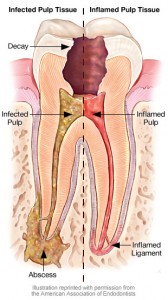Dental Crown after Root Canal
By Dr. Jeremy Jorgenson
Why may a dental crown be needed after a root canal? Well let’s start by talking about root canals. A root canal may be necessary when your tooth decay has reached the inner pulp or root of your tooth. The infection may be extremely painful or you may not even know the decay has spread to the root. Removing the tooth decay and infection is essential to preventing the spread of the infection to surrounding gum and bone tissue.
When a root canal is necessary, your dentist will use a drill or a laser to take out the decayed enamel, dentin, and the pulp to ensure all of the infected tooth is gone. Depending on how much of the natural tooth structure must be removed, and other factors, will often determine whether a dental crown is needed after a root canal. Generally, when large decay is present, the tooth has been significantly weakened, and when the tooth regularly experiences a lot of pressure (think back molar tooth), a dental crown may be appropriate to restore function.
(more…)


